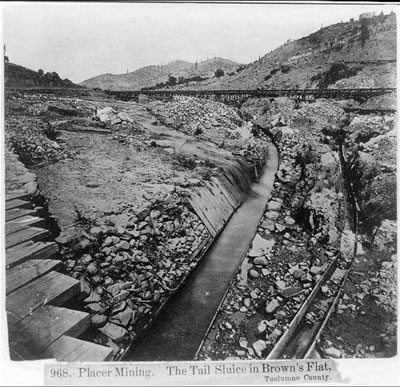The modern story of the Clark Fork Basin began with the first major industry and engine of development in western Montana- mining.

Gold & Silver
It is generally accepted that gold was discovered on Silver Bow Creek in 1864 by Bud Barker, Frank Ruff, Pete Slater (also know as Seven-up Pete) and others, called Barker and Party in the history books. The town of Silver Bow, located to the west of modern-day Butte, had around 1,000 people working the creek by the end of 1864; most of those miners followed the creek up to the Butte camps when the gold was soon panned out. Gold was dredged from the creek using placer mining techniques, and Silver Bow Creek would never be the same again. The first mills were constructed on the creek in 1868 and the first tailings from those processes were soon discharged into the stream.
It didn’t take long to pan out the gold in the creek and, with the government switching its currency to silver, underground quartz mining for silver, gold and later copper soon supplanted all types of placer operations. The only major mining-related operations on Silver Bow Creek after the placer period had subsided were smelting, processing and chemical precipitation plants.
It should be noted that while Barker and Party struck gold on the creek, Humphreys and Allison struck the first mining claim in the Butte district, but it wasn’t a gold placer operation. It was the Original Lode located on the Butte Hill. Humphreys and Allison’s claim was also recorded in 1864, making it the first mining operation on the Butte Hill proper.
To learn more about the placer mining process, visit Wikipedia’s Placer mining page.
Naming Silver Bow Creek
The following appeared in The Anaconda Standard newspaper on October 21st, 1906:
“In the organization of the district, it was necessary that a name be given the new discovery. Tradition says that the afternoon was a warm and sunny one and after the work of locating the claims had been finished the entire party climbed to the top of the butte (Sherman Butte) in whose shadow the rich discovery had been made to survey the extent of the their new discovery. Stretching away, above and below, with the water gleaming like silver in the brilliant sun was the creek, bending and twisting as it hunted the easiest grade down the valley. Just below the butte the creek made a wide bend to the north and along the center of the valley led an Indian trail. It looks like a silver bow. A silver bow it is, said seven-up Pete, and that is the name we will call this creek and district.
“Time was when Silver Bow Creek was a pretty one as it curled around the foot of the hill and dashed along the natural water course in the valley, singing merrily as it thought of the wonderful wealth of gold which it hoarded and which had been carried down from some place in the mountains so long ago that it had no recollection where or how it came to be gathered upon its bedrock. In the valley grass grew and the meadows were smiling and green. Mountain trout slept lazily in its deep pools and darted back and forth in the shallows seeking food. The deer and antelope came to the creek’s edge at evening time and drank fearlessly. Buffaloes laid about in the shade of the willows lazily during the heat of the day or else they stood knee deep in the water, chewing their cuds contentedly.”
Click here to return to the main History page
Click here to continue to 1870s-1900s: Copper and Development
